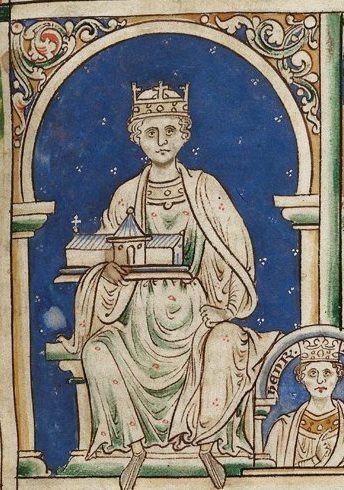by Susan Flantzer
© Unofficial Royalty 2024

King Stephen of England, father of Gervase of Blois, Abbot of Westminster; Credit – Wikipedia
Born circa 1115 – 1120, Gervase of Blois was the son of King Stephen of England and his mistress Damette (circa 1103 – 1152), from the Duchy of Normandy, then a possession of the King of England, now part of France. Gervase’s paternal grandparents were Stephen II, Count of Blois and Adela of Normandy and England, a daughter of King William I of England (the Conqueror).
Gervase had three full siblings:
- Almaric of Blois
- Ralph of Blois
- Sybille of Blois, Lady of Champagne (circa 1115 – 1141), married Hervé II, Viscount Count of Léon, had at least three children
Gervase had five royal half-siblings from the marriage of his father King Stephen to Matilda of Boulogne:
- Baldwin of Blois (circa 1126 – 1135)
- Eustace IV, Count of Boulogne (circa 1129 – 1153) married Constance of France, no children
- Matilda of Blois (circa 1133 – circa 1137), died in childhood
- Marie of Blois, Countess of Boulogne (circa 1136 – 1182) married Matthew of Alsace, had two daughters
- William of Blois, Count of Boulogne (circa 1137 – 1159) married Isabel de Warenne, no children

A scene from the Bayeux Tapestry showing the funeral procession of Edward the Confessor with the church Edward built on the left. This is the only contemporary depiction of Edward’s church, the church that Gervase would have know; Credit – Wikipedia
Today, we think of Westminster Abbey as just a church. However, it was first known as St. Peter’s Abbey, founded by Benedictine monks in 960 under the patronage of King Edgar the Peaceful (reigned 943 – 975) and St. Dunstan, Archbishop of Canterbury. King Edward the Confessor (reigned 1042 – 1066) began rebuilding St. Peter’s Abbey to provide himself with a royal burial church. This church became known as the “west minster” to distinguish it from (old) St. Paul’s Cathedral (the east minster) in the City of London. The new church was consecrated on December 28, 1065. However, until the dissolution of the monasteries (1536 – 1541) during the reign of King Henry VIII, there was also a monastery of monks at Westminster Abbey. The definition of the word abbey is “a large church with buildings next to it where monks and nuns live.” The head of a monastery is an abbot.
In 1138, when Gervase was no older than his early 20s, his father arranged for him to be appointed Abbot of Westminster, giving Westminster Abbey hope of receiving additional royal funds. Gervase was certainly too young to hold this position, and he was neither a monk nor a priest. Alberic of Ostia, the papal legate to England, immediately ordained Gervase as a priest, presumably after the necessary dispensation due to his illegitimate birth which would have prevented him from holding a religious office.
In 1139, Gervase attended the Second Lateran Council in Rome, the tenth ecumenical council recognized by the Catholic Church. Pope Innocent II sent Gervase a papal bull in 1141 outlining how to reform the finances and the estate management of Westminster Abbey. Over the years, historians have disagreed over whether Pope Innocent II was referring to long-standing issues of financial malpractice, or ones that had appeared during Gervase’s time as Abbot of Westminster.
Working with with Osbert de Clare, Prior of Westminster, Gervase tried unsuccessfully to canonize as a saint King Edward the Confessor who was buried at Westminster Abbey. Edward the Confessor would not be canonized until 1161, nearly a year after his death. In 1148, Gervase was proposed as one of the three candidates to be Bishop of Lincoln, but someone else was appointed.

King Henry II of England; Credit – Wikipedia
In 1154, King Stephen died and was succeeded by his former rival in the terrible civil war known as The Anarchy, King Henry II. King Stephen, a nephew of King Henry I, had raced to England upon hearing of the death of his uncle King Henry I, usurping the English throne from King Henry I’s only surviving legitimate child Empress Matilda. The fight for the English throne between first cousins Stephen and Matilda caused a terrible fifteen-year civil war. King Henry II was Matilda’s son and he had no love lost for King Stephen, his relatives, and his supporters, including Gervase, Stephen’s illegitimate son. King Henry II accused Gervase of mishandling the abbey’s estates and he was dismissed as Abbot of Westminster in 1157. Gervase was replaced as Abbot of Westminster by Laurence of Durham, a supporter of King Henry II. Gervase died on August 25, 1160, and was buried in the south cloister of the old Westminster Abbey.
This article is the intellectual property of Unofficial Royalty and is NOT TO BE COPIED, EDITED, OR POSTED IN ANY FORM ON ANOTHER WEBSITE under any circumstances. It is permissible to use a link that directs to Unofficial Royalty.
Works Cited
- Ashley, Mike. (1998). The Mammoth Book of British Kings and Queens. Carroll & Graf Publishers.
- Flantzer, Susan. “Westminster Abbey in London, England.” Unofficial Royalty, 2021, www.unofficialroyalty.com/westminster-abbey-in-london-england/
- “Gervaise de Blois, Abbot of Westminster.” Geni_family_tree, 2022, www.geni.com/people/Gervaise-de-Blois-Abbot-of-Westminster/6000000000769948404.
- “Gervase de Blois.” Westminster Abbey, www.westminster-abbey.org/abbey-commemorations/commemorations/gervase-de-blois.
- Weir, Alison. (2008). Britain’s Royal Families – The Complete Genealogy. Vintage Books.
